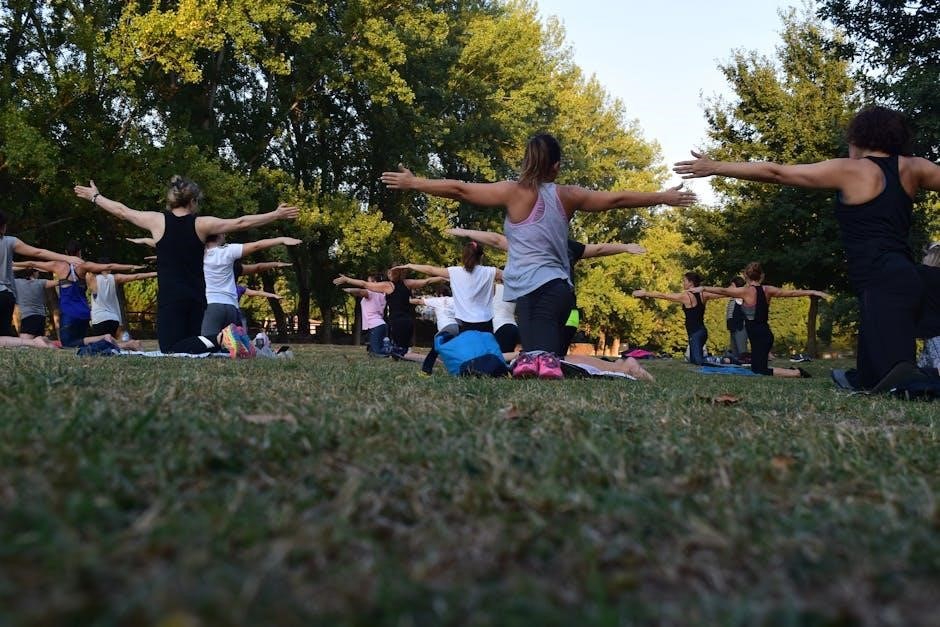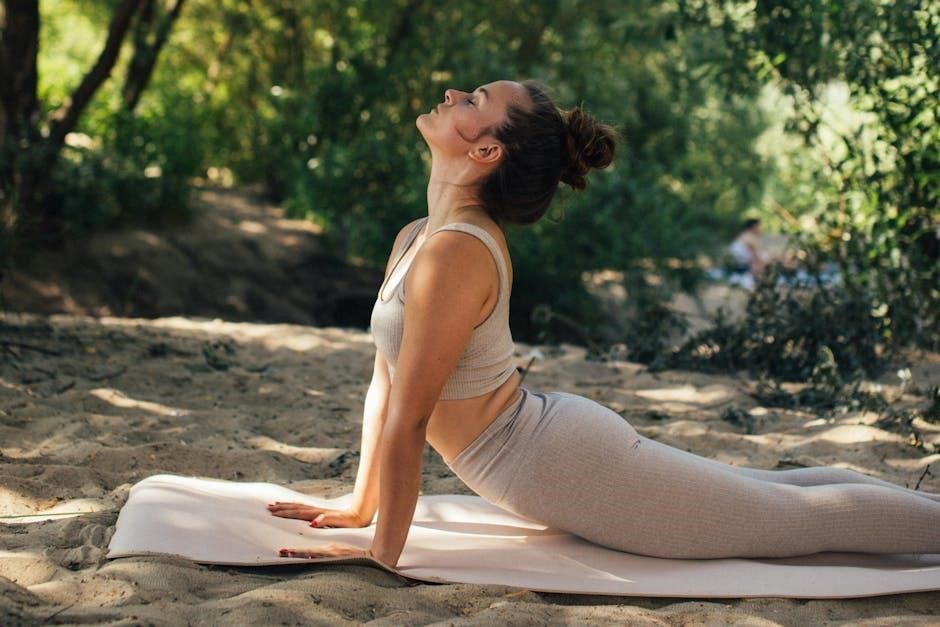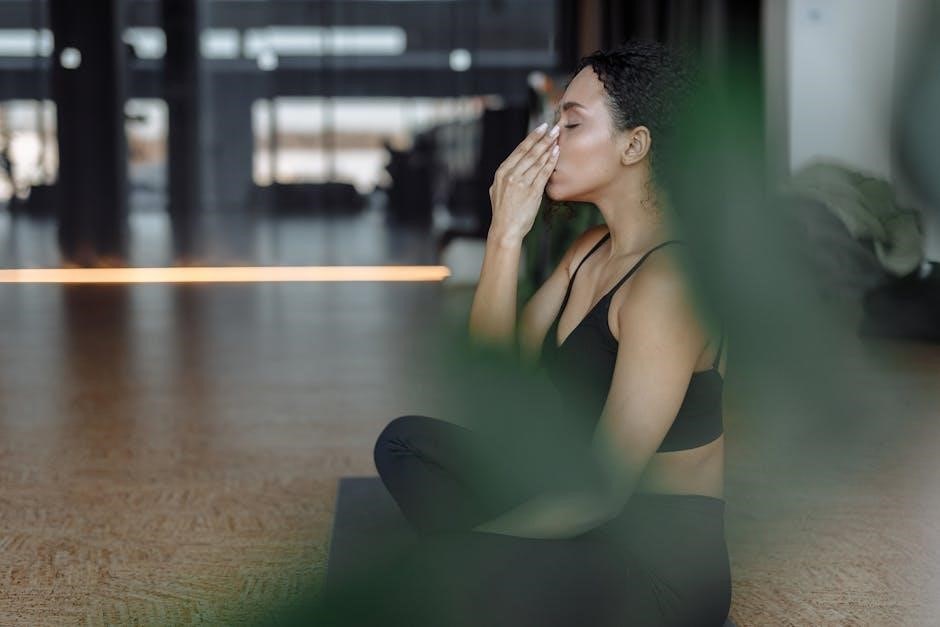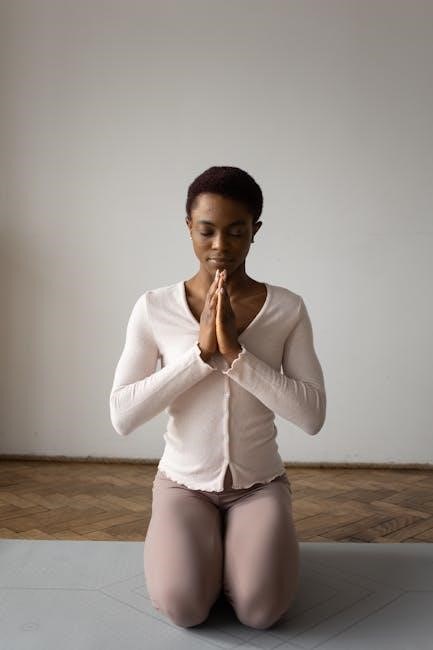The 4-7-8 Breathing Technique, developed by Dr. Andrew Weil, is a simple yet powerful method for stress reduction and relaxation. Inhale for 4 seconds, hold for 7, and exhale for 8. This practice, rooted in Pranayama, promotes a natural relaxation response, helping to calm the mind and body effectively.
What is the 4-7-8 Breathing Technique?
The 4-7-8 Breathing Technique, developed by Dr. Andrew Weil, is a simple, effective method for relaxation and stress reduction. It involves inhaling through the nose for 4 seconds, holding the breath for 7 seconds, and exhaling through the mouth for 8 seconds. Rooted in yoga’s Pranayama, it promotes a natural relaxation response, calming the mind and body. This technique is easily incorporated into daily life, requiring minimal time and effort, making it a widely accessible tool for managing anxiety and improving sleep quality.
Origins and Development by Dr. Andrew Weil
The 4-7-8 Breathing Technique, also known as the “Relaxation Breath,” was popularized by Dr. Andrew Weil, a pioneer in integrative medicine. Drawing from traditional yogic breathing practices, Dr. Weil adapted this method to create a simple, accessible tool for modern individuals. Originating from Pranayama, an ancient Indian practice, the technique was refined by Dr. Weil to emphasize its therapeutic benefits, particularly for stress reduction and anxiety management. His work has made this powerful breathing exercise widely recognized and used globally, bridging the gap between traditional wisdom and contemporary health practices.

How the 4-7-8 Breathing Technique Works
The technique slows the heart rate, promoting relaxation by extending exhale duration, which activates the parasympathetic nervous system, naturally calming the body and mind.
Physiological Effects of the Technique
The 4-7-8 breathing technique triggers the parasympathetic nervous system, promoting relaxation. It slows the heart rate, lowers blood pressure, and enhances oxygenation. By extending the exhale phase, it reduces stress hormones like cortisol. This method also improves sleep quality by calming the nervous system and increasing oxygen flow to organs. Regular practice strengthens respiratory and cardiovascular health, leading to better emotional regulation and reduced anxiety. The controlled breathing pattern creates a meditative state, fostering mindfulness and mental clarity. These physiological effects make the technique a holistic approach to overall well-being.
Role of Pranayama in the 4-7-8 Method
The 4-7-8 breathing technique draws heavily from Pranayama, an ancient yogic practice focusing on breath control. Pranayama aims to balance life energy and consciousness. The 4-7-8 method adapts this by using a specific ratio of inhalation, retention, and exhalation to induce relaxation. By extending the exhale phase, it aligns with Pranayama’s goal of calming the mind. This technique honors the traditional principles of yogic breathing while offering a structured approach for modern stress relief. Its roots in Pranayama ensure a holistic practice that connects physical, mental, and emotional well-being.

Steps to Perform the 4-7-8 Breathing Exercise
Sit comfortably with straight posture. Inhale deeply through your nose for 4 seconds, filling your lungs fully. Hold your breath for 7 seconds, then exhale slowly through your mouth for 8 seconds, emptying your lungs completely. Repeat this cycle 3-4 times, focusing on the rhythm to achieve relaxation and calmness effectively.

Proper Posture and Positioning
Proper posture is essential for the 4-7-8 breathing technique to be effective. Sit comfortably with your back straight, shoulders relaxed, and hands placed gently on your belly or chest to feel the breath movement. Keep your mouth closed and tongue soft, ensuring the breath flows naturally through your nose. Your body should be in a relaxed position, avoiding tension in the neck or shoulders. While sitting is recommended, you can also practice lying down, though be cautious not to fall asleep. Consistent posture helps maintain focus and ensures the breath cycle is completed smoothly and effectively for optimal relaxation benefits.
Counting and Timing in the Exercise
Counting and timing are crucial components of the 4-7-8 breathing technique. Begin by inhaling quietly through your nose for a count of four seconds, filling your lungs completely. Hold your breath for seven seconds, allowing oxygen to circulate and your body to relax. Finally, exhale slowly through your mouth for eight seconds, emptying your lungs fully. The ratio of 4:7:8 is key, ensuring each phase is executed in balance. Using a timer or mental counting helps maintain consistency, allowing you to focus on the rhythm and deepen relaxation. Practice regularly to master the timing and enhance the technique’s benefits effectively.

Benefits of the 4-7-8 Breathing Technique

Promotes relaxation, reduces stress and anxiety, and improves sleep quality by inducing a natural calming response through its structured breathing pattern.
Stress Reduction and Anxiety Management
The 4-7-8 technique is highly effective for stress reduction and anxiety management. By focusing on controlled breathing, it disrupts the body’s “fight-or-flight” response, promoting relaxation. Regular practice lowers cortisol levels, alleviates anxiety symptoms, and enhances emotional resilience. This method is particularly beneficial during stressful moments, offering a quick, natural way to calm the nervous system. Its simplicity makes it accessible anytime, helping individuals regain composure and mental clarity. Over time, consistent use can lead to long-term reductions in stress and anxiety, improving overall well-being.
Improvement in Sleep Quality
The 4-7-8 breathing technique is renowned for its ability to improve sleep quality. By slowing down breathing and inducing relaxation, it helps individuals fall asleep faster and enjoy deeper, more restorative sleep. This method reduces stress hormones like cortisol, creating a calm environment for the body to transition into sleep mode. Regular practice can address insomnia and restlessness, promoting consistent sleep patterns. Its effectiveness lies in its ability to quiet the mind and relax the body, making it an ideal pre-sleep routine. Over time, this technique can lead to improved sleep duration and enhanced overall sleep health.

Practical Applications of the 4-7-8 Technique
The 4-7-8 breathing technique is versatile and can be practiced anytime, anywhere. Use it at home, in the office, or during travel for quick stress relief.
When and Where to Practice
The 4-7-8 technique is adaptable to various settings, making it ideal for daily use. Practice it in the morning to start your day calmly or before bed to enhance sleep. You can also use it during breaks at work or while traveling to manage stress. The key is consistency; regular practice, even just a few minutes a day, can lead to significant benefits; Finding a quiet, comfortable spot to focus on your breathing is recommended, but it can be done anywhere, even in busy environments, as it requires minimal space and time.
Integrating the Technique into Daily Routine
Incorporating the 4-7-8 breathing technique into your daily routine is straightforward and requires minimal time. Start by practicing it once a day, ideally during moments of calm, such as first thing in the morning or before bed. Gradually increase to 3-4 cycles as you become more comfortable. Consistency is key; even a few minutes daily can yield benefits. You can also integrate it into your existing habits, such as right after meditation or yoga. Over time, it becomes a natural part of your self-care routine, helping you stay centered and relaxed throughout the day.

4-7-8 Breathing PDF Guide

A handy 4-7-8 breathing PDF guide provides concise instructions and timing for the technique, serving as a quick reminder for practice. Download and print it for easy reference.
Elements of a Printable PDF Guide
A comprehensive 4-7-8 breathing PDF guide includes step-by-step instructions, breathing patterns, and timing details. It often features visual aids like diagrams and charts to illustrate proper posture and breathing techniques. The guide may also include sections on the benefits of the method, such as stress reduction and improved sleep quality. Additionally, it might offer tips for incorporating the practice into daily routines, making it easier for users to adopt the technique consistently. Some guides include space for notes or progress tracking, enhancing user engagement and adherence to the practice.
Downloading and Using the Guide
The 4-7-8 breathing PDF guide can be easily downloaded from reputable health websites or platforms offering mindfulness resources. Once downloaded, print it for convenience and place it in visible locations like your fridge or office wall. The guide serves as a quick reference, reminding you of the technique’s steps and timing. Use it to practice the breathing exercise daily, especially during stressful moments or before sleep. Its straightforward design ensures accessibility, making it a valuable tool for incorporating the 4-7-8 method into your routine for improved relaxation and well-being.

Risks and Limitations of the 4-7-8 Technique
The 4-7-8 technique may cause lightheadedness or discomfort for some. It should be avoided during pregnancy or severe respiratory conditions without medical consultation.
Potential Side Effects and Contraindications
While the 4-7-8 technique is generally safe, it may cause dizziness or lightheadedness due to prolonged breath-holding. Overbreathing can lead to respiratory alkalosis. Individuals with severe respiratory conditions, heart disease, or high blood pressure should consult a doctor before practicing. Pregnant women and those with a history of panic attacks should avoid this technique. Additionally, people with low blood pressure may experience fainting during or after practice. It is essential to start slowly and modify the technique if discomfort arises.
When Not to Use the Technique
The 4-7-8 breathing technique is not suitable for everyone. Individuals with severe respiratory issues, such as chronic obstructive pulmonary disease (COPD), should avoid it due to the breath-holding phase. Those with heart conditions, including arrhythmias, should consult their doctor before practicing. Pregnant women, especially in the first trimester, should exercise caution. People with a history of panic attacks or anxiety triggered by breathwork should avoid this method. Additionally, individuals with low blood pressure or those prone to fainting should use the technique cautiously, if at all, and only under medical guidance.
The 4-7-8 breathing technique offers a simple, effective way to reduce stress and improve relaxation. Regular practice can enhance overall well-being and promote better sleep quality naturally.
The 4-7-8 breathing technique, developed by Dr. Andrew Weil, is a highly effective method for reducing stress and promoting relaxation. By focusing on specific inhalation, retention, and exhalation timings, it triggers a natural calming response in the body. This practice, rooted in Pranayama, helps alleviate anxiety, improves sleep quality, and enhances overall well-being. Its simplicity makes it accessible to everyone, while its benefits extend to both mental and physical health. Regular practice can lead to long-term improvements in emotional regulation and stress management, making it a valuable tool for maintaining a healthy lifestyle.
Encouragement for Regular Practice
Regular practice of the 4-7-8 breathing technique can lead to profound improvements in both mental and physical well-being. By dedicating just a few minutes daily, individuals can cultivate a sense of calm, reduce stress, and enhance sleep quality. This simple yet powerful practice is accessible to everyone, requiring no special equipment or advanced skills. Consistency is key, as it helps develop a lasting habit that promotes relaxation and emotional balance. Encourage yourself to embrace this technique as a daily ritual, empowering you to take control of your health and fostering a more serene, focused lifestyle over time.